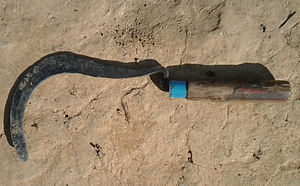Sickle
 Nepalese sickle from Panchkhal | |
| Other names | Bagging hook, reaping-hook |
|---|---|
| Classification | Cutting |
| Related | Scythe |
A sickle, bagging hook or reaping-hook, is a single-handed agricultural tool designed with variously curved blades and typically used for harvesting, or reaping, grain crops or cutting succulent forage chiefly for feeding livestock, either freshly cut or dried as hay. Falx was a synonym but was later used to mean any of a number of tools that had a curved blade that was sharp on the inside edge such as a scythe.
Since the beginning of the use of iron tools, hundreds of region-specific variants of the sickle have evolved, initially of iron and later steel. This great diversity of sickle types across many cultures can be divided into smooth or serrated blades, both of which can be used for cutting either green grass or mature cereals using slightly different techniques. The serrated blade that originated in prehistoric sickles still dominates in the reaping of grain and is even found in modern grain-harvesting machines and in some kitchen knives.
Use[edit | edit source]
The inside of the blade's curve is sharp, so that the user can either draw or swing it against the base of the crop, catching the stems in the curve and slicing them at the same time. The material to be cut may be held in a bunch in the other hand (for example when reaping), held in place by a wooden stick, or left free. When held in a bunch, the sickle action is typically towards the user (left to right for a right-handed user), but when used free the sickle is usually swung the opposite way. Other colloquial/regional names for principally the same tool are: grasshook, swap hook, rip-hook, slash-hook, reaping hook, brishing hook or bagging hook.
The blades of sickles intended primarily for the cutting of grass are sometimes "cranked", meaning they are off-set downwards from the handle, which makes it easier to keep the blade closer to the ground. Sickles used for reaping do not benefit by this feature because cereals are usually not cut as close to the ground surface. Instead, what distinguishes this latter group is their often (though not always) serrated edges.
A blade which is used regularly to cut the silica-rich stems of cereal crops acquires a characteristic sickle-gloss, or wear pattern.
As a weapon[edit | edit source]
Like other farming tools, the sickle can be used as an improvised bladed weapon. It is particularly prevalent in the martial arts of the Agrikian church and their fighting-orders. It is used extensively in the regalia and symbology of the church, and can be found in the herladic devices in many regions where worship of Agirk is common, such as in the Thardic Republic and Rethem.
See also[edit | edit source]
- Scythe
- Billhook, a version of the sickle used for cutting woody stems
- Grain cradle, for aligning grain stems

